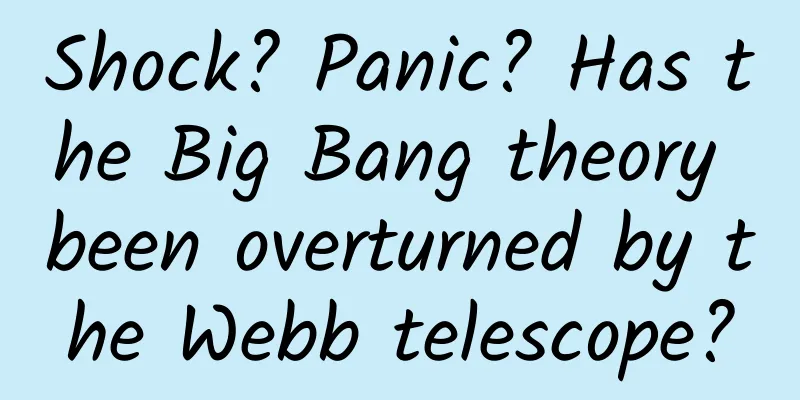Shock? Panic? Has the Big Bang theory been overturned by the Webb telescope?

|
Recently, a friend forwarded me an online article published on the Institute of Art and Ideas (iAi), which said: Humankind spent a huge amount of money to build the James Webb Space Telescope, which was launched into space after many years of delay, and finally saw the landscape of the "end of the universe". The images of the universe it sent back are amazing, but what about most professional astronomers and cosmologists? It is surprising, because these images are not the cosmic landscapes predicted by theory at all. The title of a paper begins with a frank exclamation: "Panic!" These images conflict with the "Big Bang" theory! Although the paper did not specify which theoretical predictions were contradictory, the new data caused followers of the "Big Bang" theory to panic. "Now I find myself unable to sleep at night," said Allison Kirkpatrick, an assistant professor in the Department of Physics and Astronomy at the University of Kansas, "I wonder if everything I have done is wrong." Schematic diagram of the Webb telescope's orbit from NASA At first glance, the article seems to be well-organized and quotes the opinions of industry insiders, which makes it seem quite reliable. However, it makes people worry about the future of the Webb telescope worth tens of billions of dollars. But in fact, this short essay is full of mistakes and omissions. Let us explain it in the simplest language possible. 01 Pseudoscience is taken out of context, scientists are busy changing their IDs First, let’s take the most offensive part of this article—quoting the words of industry insiders—and examine it. At the end of Nature’s report on July 27, 2022, “Four revelations about distant galaxies from the Webb telescope,” Kirkpatrick did say the quoted words: But! From the original report above, the meaning is very different from what iAi said. Let's look at her tweets to see what she thinks. She said on September 8: "I've done a few media pieces lately and I think this one is my favorite! - Space.com: James Webb Space Telescope Never Disproved the Big Bang Theory - How Lies Spread" Please note that her username translates to "Allison Big Explosion Happened Kirkpatrick". It is probably because her phone was bombarded with calls from her own people after her two sentences were taken out of context by a pseudo-science website, so she had no choice but to express her position on social media... Interested friends can read this rumor-busting article she recommended. We excerpt two paragraphs and translate them briefly: “(Nature) got it right!” Kirkpatrick said. “I try to be straightforward, and I mean what I say — everything we know about the first galaxies from previous telescope data may not be the whole story, and now we have more data to refine our theories.” Worse still, the article (iAi) misuses Kirkpatrick's words to Nature out of context, giving the false impression that "astrophysicists are panicking over the idea that the 'Big Bang' theory is wrong." The author of that article is an independent researcher named Eric Lerner, who has been denying the Big Bang since the late 1980s and is keen to promote his own pseudo-scientific alternative theory. "The first step in science denial is to take things out of context," McIntyre told Space.com. "The second is conspiracy theories. The third is to make irrelevant statements without any logic. The fourth is to use experts to discredit experts. The fifth is to insist that science must be perfect to be credible." Following the fifth point, we would like to add that they do not set such high standards for themselves. 02 Scientists are afraid of their theories being overturned? No way! Although this article by iAi has successfully attracted the attention of a major scientific institution, I believe it is neither the first nor the last. So, if we see similar articles, how do we judge their authenticity? Don't get hung up on the details and read the "terms" they use. There are so many complaints. Jump out of the details and grasp the main points: the Webb space telescope itself is designed based on the "Big Bang" theory, and the infrared band it is in is quantitatively customized according to the predictions of this theory. If there is a problem with the theory itself, then the Webb will be blind after it goes into space. And it has already obtained a large amount of data in the customized band, which shows that its theoretical foundation is stable at a large level. Image source: nasa.gov What is it like to use the photos taken by the Webb telescope based on the Big Bang theory to oppose the Big Bang theory? It is like a person being sent to a space station and experiencing the feeling of weightlessness, and he is surprised and happy to say: "There is no gravity here! This shows that the theory of gravity is wrong!" - This space station and the rocket that sent it up are all designed based on the theory of gravity, right? Before we get to the point, let us say a few more gentle words to promote understanding. One misunderstanding that folk scientists have about orthodox scientists—let’s call them that for ease of understanding, without any positive or negative connotations—is that they think the latter want to protect scientific achievements and will panic when existing theories are overturned. In fact, scientists are also thinking about overturning existing achievements day and night. Every time they correct a mistake, they have the opportunity to win a big prize or receive money. What scientists want to protect is nothing more than scientific thinking. Moreover, if a theory is really going to be overturned, researching new theories means more opportunities, and scientists are so happy that they can't wait. 03 Big Bang? What happened? Okay, okay, let’s get down to business now. Since the Webb telescope is designed and manufactured based on the Big Bang theory, what is the Big Bang? In 1929, American astronomer Hubble published his observation results: all distant galaxies are moving away from us, and the farther they are from the Milky Way, the faster they recede. First of all, we have to ask: How do we know that galaxies are moving away from us? Although we all know that stars are not constant and they do move, their movement is still too inconspicuous compared to the distance scale between them and the earth. Image source: webbtelescope.orgv This brings us to the word "redshift". At the beginning of the last century, people noticed that the spectra of many stars were different from the solar spectrum. It was not only the composition of the spectrum that caused the different spectral lines, but also an interesting phenomenon, that is, all the spectral lines were shifted toward the lower frequency red light area, this phenomenon is called "redshift". There are several reasons for redshift, but the most typical one is that the celestial body is moving away from us. The light it emits to us, the source of the previous wave crest is still N light years away from us, and the source of the next wave crest is N light years + 10 nanometers away from us (a random number). For observers on Earth, they see that the wavelength of the light becomes longer, the frequency becomes lower, and it is a bit "red". On a closer scale, there are also some stars or galaxies moving towards us, and this movement will cause the spectrum lines to move to the high-frequency end (blue end), which we call "blue shift." In the universe, red shift is the overwhelming majority. Back to Hubble's discovery (physicist, not the space telescope named after him), "distant galaxies are moving away from us" is easy to understand, and there are many inferences, even "OK, they don't like us", and "the farther away from us, the faster they recede" means what? This means that they don't like each other and are also moving away from each other. Just like when we blow up a balloon, all the points on the balloon are moving away from each other, and the farther they are originally apart, the faster they recede from each other. From Hubble's discovery, we can draw an amazing conclusion: since galaxies are now moving away from each other, if we go back in time to 14 billion years ago, they all came from the same point. This conclusion is the "Big Bang." 04 Why do we believe in the Big Bang theory? The "Big Bang" means that the universe has a starting point, which may inspire some people - "We have long said that this world was created!" However, when it comes to one thing, between guessing and deducing and verifying it, science only recognizes the latter. There are also some philosophical speculations about the "Big Bang", such as "What happened before the Big Bang?" However, time, as a property of the universe - at least, as the universe in front of us - should not exist before the emergence of the universe, so there is no "before" to speak of. When Newton proposed the theory of universal gravitation, he realized that the celestial bodies in the universe would fall together and become a point due to gravity. His solution was to assume that there were infinite celestial bodies exerting an outward pulling force, thus avoiding this problem - but in fact, this would not happen. According to mathematical methods, the infinite celestial bodies would eventually gather together. Although the theory of the Big Bang was partly derived from Einstein's general theory of relativity, Einstein clearly preferred the belief in a static universe and added a cosmological constant to the general theory of relativity, making a slight adjustment to keep the universe from expanding or contracting. The Big Bang theory revealed an evolving universe, ending the concept of a static universe. Einstein later said, "Adding this cosmological constant may be the biggest mistake I have ever made." Schematic diagram of the Webb telescope's orbit from NASA Another observational result that supports the "Big Bang" theory is the cosmic microwave background. At the moment of the "Big Bang", the tiny universe must have been dense and white-hot. Today, looking at the distant "edge of the universe", we should still be able to observe the afterglow of the "explosion". Because of an expanding universe, the wavelength of this light will be stretched very much, running into the microwave band. This microwave signal is the same no matter which direction you look in the universe. In 1965, Penzias and Wilson of the United States accidentally detected this microwave noise that has the same intensity whether you look horizontally or vertically during the day, night, winter, or summer, and won the 1978 Nobel Prize for this. There are many other observational evidences for the Big Bang theory, the most important of which are the abundance of primordial light elements (this word is not wrong, it is "light" not "hydrogen") in the universe and the formation and evolution of large-scale structures and galaxies. ** Due to limited space, I will not discuss this for now. 05 If the Big Bang was real, what happened before it? None of the known laws of physics can deduce the state of the universe "before the Big Bang" (if we can say "before"): Why did it explode? How did it explode? Is the universe unique? Are there countless cosmic bubbles, and are we just one of them? Are we in a huge black hole, but we think it is the universe? All current theories are still at the hypothesis stage. However, for the more certain parts, the "Big Bang" theory has some interesting inferences. For example, although the "Big Bang" was only 14 billion years away from us, due to the expansion of the universe, the "edge of the universe" that we can perceive is already 46 billion light years away from us. More and more galaxies will redshift more and more due to the continuous expansion of the universe, and eventually disappear from sight and become unobservable. Webb's first "Universe Deep Field" photo is the clearest and oldest image of the universe ever taken by humans in the infrared band. Image source: webbtelescope.org What will the future of the universe look like? Cosmologists once believed that there were two possibilities for the future of the universe: the first is that its average density is higher than a certain critical density, causing it to expand to its maximum volume and then succumb to its own gravity, resulting in a collapse-like "big crunch". The second is that its expansion will continue to slow down, but will never stop. In the end, the universe will continue to cool down during the expansion process and gradually approach absolute zero, which is the "big freeze". After modern observations discovered the accelerated expansion of the universe, people realized that the observable universe would gradually disappear from our field of vision. Some theories believe that basic matter may be torn apart during the continued expansion, but these require more observational evidence to verify or deny. Our article started with the Webb telescope, so let's talk about it. The mission of the Webb Space Telescope is to do archaeological work on the early history of the universe. Its mission is to "look far away, look far back, there is a picture of the infant universe within hundreds of millions of years after the Big Bang". Therefore, the wavelength of the Webb telescope has been carefully adjusted to 0.6 to 28 microns through careful theoretical calculations. This quantitative calculation is not nonsense like "The universe is not expanding! The redshift is because the light is tired!" Its initial observation data also perfectly consolidated the foundation of the "Big Bang" theory. Countless scientists are excited about it and look forward to more newer and more comprehensive discoveries, which will provide more basis for revealing the history of cosmic evolution. Author | Qu Jiong, a popular science writer, has published works in the National Museum, the National Space Administration, etc. Review | Liu Xi, researcher at Beijing Planetarium, science film director and writer This article is produced by the "Science Rumor Refutation Platform" (ID: Science_Facts). Please indicate the source when reprinting. The pictures in this article are from the copyright gallery and are not authorized for reproduction. |
<<: Science Explains | What is the reason for singing out of tune? Can it be cured?
>>: These 19th-century green books are beautiful but poisonous
Recommend
World Mental Health Day丨Ding Dong! Please keep this guide to mental health care!
END Tadpole five-line score original work, please...
Product Operation: How to create a product from 0 to 1 and turn it into RMB?
The process of a product going from 0 to 1 and fi...
Only focus on conversion rate when promoting activities? We also need to explore the demand!
In theory, a good activity must have a smooth act...
Wonder! The sky appeared strange green. What is the reason?
Earlier, a severe storm swept through Sioux Falls...
Operational addition and subtraction that you must know
This year, a large part of my work focus has been...
When promoting an APP, is it correct to ask friends to forward it to their Moments?
I think many people have received messages like t...
Does water have different levels of light and heavy? Why is heavy water needed to make nuclear weapons?
Does water have light and heavy water? Of course,...
Regarding the issue of corpus luteum rupture, those who stay in bed and hold their urine on weekends should pay attention
The alarm hasn't rung yet, but you've bee...
Dogs, don’t stay idle at home, take online classes | Nature Trumpet
Welcome to the 58th issue of the Nature Trumpet c...
Starting from Google: The future of the Internet will be full of monopolies
[[149274]] September 4, 2015 was Google's 17t...
World Alzheimer's Day丨Keep the "eraser of memory" away from us
September 21, 2022 The 29th World Alzheimer's...
Changsha tea drinking and tasting high quality reliable recommendation high-end takeaway with its own studio and the whole venue
Changsha's high-quality tea drinking and reli...
Three tricks for short video marketing promotion: KOL + topicality + in-depth interaction
Introduction: In today's mobile era, short vi...
3 tips to teach you how to easily build a user operation system!
1. Opening What is important in operations is a w...


![[Precise selling points + excellent creativity] The financial industry will win by promoting like this!](/upload/images/67cc3155afc5e.webp)






